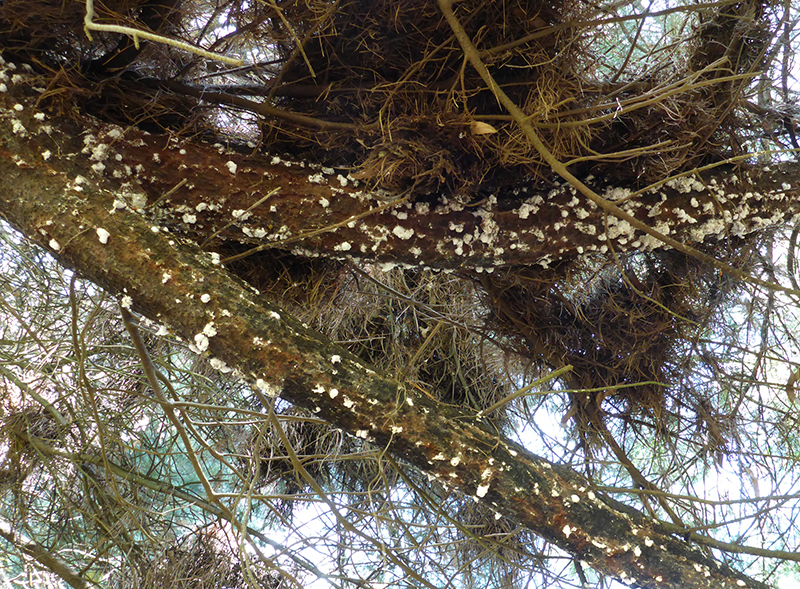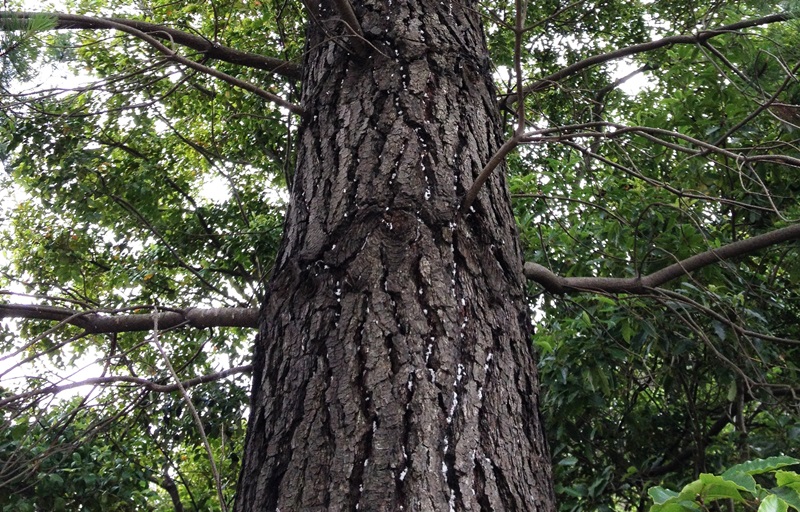Giant pine scale
Giant pine scale (Marchalina hellenica) is a tiny scale insect that lives by sucking the sap of pine, fir and spruce trees.
If left unmanaged this tiny insect can built up to large numbers. Heavily infested trees can dry up and die impacting our parks, forests, softwood plantation and residential properties.
An active containment program is underway in Victoria. Early reporting is essential to stop the spread. You can report suspect sightings of giant pine scale to Agriculture Victoria by using the public online reporting form or phoning the Customer Contact Centre on 136 186.
This insect is native to the eastern Mediterranean regions, specifically Greece and Turkey.
What does it look like?
Giant pine scale infested trees have white cotton wool-like wax on their trunks and branches (Figure 3). While the insect typically prefers the lower part of the tree - the trunk (Figure 4), it can also be found on branches and exposed roots.
Adults grow up to 12 millimetres in length (Figure 1). Each female produces over 300 eggs (Figure 2) between November and January, which then hatch into crawlers.




Giant pine scale in Victoria
Giant pine scale was confirmed in Melbourne's south-eastern suburbs and in Adelaide for the first time in 2014. This small sap sucking insect is native to the eastern Mediterranean regions, specifically Greece and Turkey.
Infested trees are present in suburban Melbourne and current known areas of GPS infestation can be found on the map below (Figure 5).

Potential impact of giant pine scale
Giant pine scale live in large numbers and can affect the health and safety of the trees they live on. Heavily infested trees can dry up and die from the insects feeding on the tree's sap. If not properly managed, they can impact our:
- parks
- forests
- softwood plantations
- residential properties.
How giant pine scale spreads
Giant pine scale spreads by crawling to nearby host trees.
People can also unintentionally spread it when they:
- move infested plant material (for example, branches, mulch and logs)
- use contaminated gardening equipment
- carry it on clothing, machinery and cars.
So, it's important to take precautions to avoid spreading the pest to other trees.
Host trees
- Pinus halepensis (Aleppo pine)
- Pinus radiata (Monterey pine)
- Pinus pinea (stone pine).
Overseas, giant pine scale has also been found on the following species:
- pines (Pinus brutia, P. sylvestris, P. kochiana, P. laricio tauricus, P. nigra salzmannii, P. sosnowskyi)
- firs (Abies cephalonica, nordmenniana)
- spruces (Picea engelmanni, P. orientalis).
Non-host trees
Trees that can look similar to pines, spruces and firs but are not hosts of giant pine scale include cypresses, Araucaria (such as the monkey puzzle tree), she-oaks (Allocasuarina, Casuarina) and cypress-pines (Callitris).
Lifecycle of giant pine scale
November - January
Adult female can produce over 300 eggs, which tear through the dead female’s body.
January – May
Crawlers hatch from eggs and are initially only 1 mm in length.
May – September
Later stage crawlers can be up to 7 mm in length. Insects moves up and down and between trees and can move 50 m in one year.
September – November
Adult female grows up to 12 mm in length. They produce their own eggs, which are stored within their body.
Managing giant pine scale
There's a new insect being found in Melbourne's south-east called giant pine scale. Giant pine scale is a tiny scale insect that feeds on the sap of pine, fir, and spruce trees. Between November and January, each female produces over 300 eggs, which hatch into crawlers between late November to May. Giant pine scale infested trees have white cotton wool-like wax on their trunks and branches. Adults typically prefer the trunk, however it can also be found on branches. They continue to grow up to 12 millimetres, and around September, they produce eggs within their bodies and eventually die.
The problem with giant pine scale, is that they eventually kill trees they live on. Heavily infested trees can dry up and die from the insects drinking the tree's sap, impacting parks, forests, plantations and homes and the aesthetic value of neighbourhoods if not managed.
Giant pine scale spreads by crawling between host trees and by people moving infested plant material, gardening equipment, and machinery. Take care to avoid spreading the pest if it's on your property or one you're working on. Consider cutting down the entire tree. Dispose of infested tree material via your green rubbish bin or by leaving them on your property if there is enough land. Clean all plant material off used gardening equipment using a solution of 80% methylated spirits and 20% water and paper towel.
For advice on managing trees on your property, speak to an arborist or tree specialist. Arborists or tree specialists who work with host or infested trees should practice good hygiene to avoid spreading giant pine scale to other properties. Check and decontaminate your clothing, machinery and tools for signs of pest, soil or plant material before leaving the property.
When transporting infested material for disposal, remember to fully cover up your load, so that infested plant materials don't fall of during transit. If you find giant pine scale on a pine, spruce or fir tree outside of Melbourne's south-east, report it to Agriculture Victoria. Avoid collecting samples from infested trees, as this can spread the insect further.
For more information on managing giant pine scale, visit www.vic.gov.au/giantpinescale.
The following gardening and equipment hygiene tips will assist residents, landholders, gardeners and contractors in managing giant pine scale infested trees to avoid further spread.
Residents and landholders
If you have giant pine scale on your property, there are a range of things you can do to help minimise its spread:
- Where possible, keep fallen or cut tree branches on your property.
- Cut any infested branches that hang over the house or any structures (for example, shed, tanks, swings and fences).
- Dispose of unwanted tree branches, needles and pinecones using your green waste or local council transfer station (remember to bag or cover your waste during transport).
- Clean all plant material off gardening equipment using an 80% methylated spirits to 20% water solution and a brush or paper towel.
- If you decide to have the tree removed, hire an arborist who has been trained in handling giant pine scale infested trees.
Contractors working with infested trees
When working on infested trees, it's important to practise good plant and equipment hygiene to avoid spreading giant pine scale to other properties:
- When entering a site, take a hygiene kit with you that includes paper towels, 80% methylated spirits to 20% water solution, a bristle brush, disinfectant wipes, plastic bags and spare clothes.
- Check the site for any pests or diseases.
- Clean and decontaminate equipment between trees using the methylated spirit solution or disinfectant wipes.
- Clean and decontaminate your machinery, tools and clothing (or change into spare clothing) before leaving the site.
- When transporting infested material for disposal, remember to fully cover your load so insects don't escape during transit and to dispose of material to avoid further spread.
Other resources
Take the Giant pine scale eLearning course. Note this course is hosted on the Agriculture Victoria Learning Management System. Please register and choose this course from the Goals Catalogue.
Photo credits
Figures 1–5, Agriculture Victoria, Department of Energy, Environment and Climate Action (DEECA).
Reporting an unusual pest or disease of plants
Report any unusual plant pest or disease immediately using our online reporting system or by calling the Exotic Plant Pest Hotline on 1800 084 881. Early reporting increases the chance of effective control and eradication.
Please take multiple good quality photos of the pests or damage to include in your report where possible, as this is essential for rapid pest and disease diagnosis and response.
Your report will be responded to by an experienced staff member who may seek more information about the detection and explain next steps.
Report online